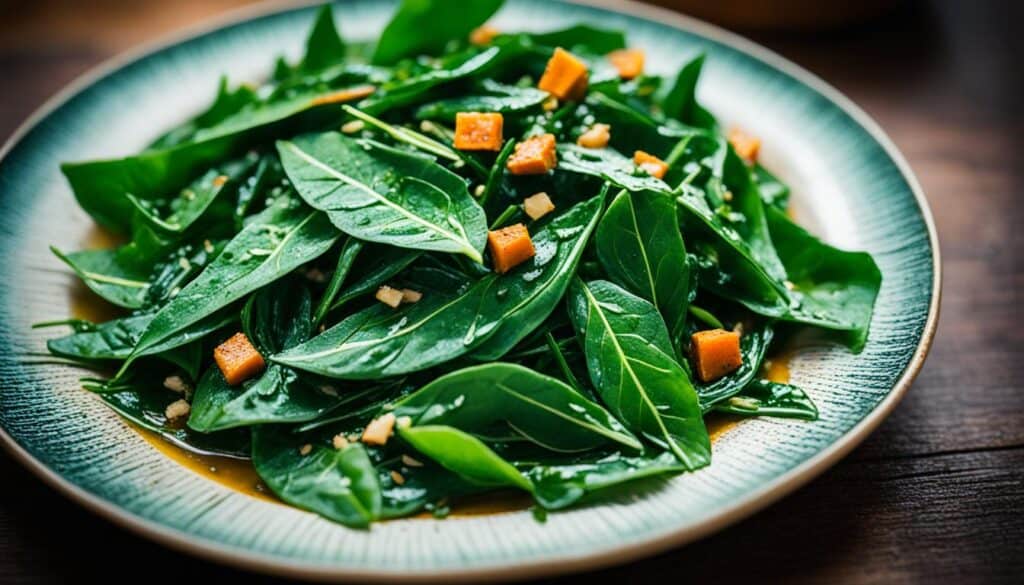Did you know that sweet potato leaves are a nutritional powerhouse, packed with essential vitamins, minerals, and antioxidants? These versatile leaves offer a range of health benefits, making them a valuable addition to any diet.
Research has shown that sweet potato leaves are rich in protein, Vitamin C, potassium, and manganese, among other nutrients. Consuming sweet potato leaves can help improve immune function, reduce oxidative stress, lower cardiovascular disease risk, and even suppress cancer cell growth. With their unique nutritional profile, sweet potato leaves can elevate both the taste and healthiness of your meals.
Key Takeaways:
- Sweet potato leaves are highly nutritious and rich in essential vitamins and minerals.
- Consuming sweet potato leaves can support immune function and reduce the risk of chronic diseases.
- These versatile leaves can be used in a variety of culinary dishes.
- Sweet potato leaves are relatively easy to cultivate and harvest.
- Proper selection and preparation of sweet potato leaves are important for maximizing their nutrients.
Nutritional Value of Sweet Potato Leaves
Sweet potato leaves are a nutritional powerhouse, providing a wide array of vitamins and minerals that contribute to overall health and well-being. These vibrant green leaves are not only delicious but also offer numerous health benefits.
Loaded with Essential Vitamins
Sweet potato leaves are particularly rich in Vitamin C, which is essential for boosting the immune system and promoting collagen production for healthy skin, bones, and connective tissues. They also contain significant amounts of other vitamins, including:
- Vitamin A: Supports healthy vision and plays a role in immune function.
- Vitamin K: Contributes to proper blood clotting and bone health.
- Vitamin B1: Helps convert food into energy and supports nerve function.
- Vitamin B2: Important for energy production and maintenance of healthy skin.
- Vitamin B3: Plays a role in cellular metabolism and energy production.
- Vitamin B9: Also known as folate, it is crucial for cell growth and development.
Essential Minerals for Optimal Health
In addition to being a vitamin powerhouse, sweet potato leaves also provide essential minerals that contribute to overall health. These include:
- Calcium: Important for maintaining strong bones and teeth.
- Iron: Essential for transporting oxygen throughout the body.
- Magnesium: Supports proper muscle and nerve function.
- Phosphorus: Involved in bone formation and energy metabolism.
- Potassium: Helps regulate blood pressure and maintain proper fluid balance.
Sweet potato leaves are also low in sodium, making them a healthy option for individuals looking to reduce their sodium intake.
Furthermore, sweet potato leaves are packed with antioxidants, which help combat oxidative stress and inflammation in the body. These antioxidants contribute to overall health and may help protect against chronic diseases.
Sweet potato leaves are not only delicious but also provide a myriad of essential vitamins, minerals, and antioxidants. Incorporating these nutritious leaves into your diet can support your overall health and well-being.
Health Benefits of Sweet Potato Leaves
Consuming sweet potato leaves can have numerous health benefits. The high levels of antioxidants found in these leaves can help reduce the risk of chronic diseases such as heart disease, hypertension, and certain types of cancer. Sweet potato leaves are also rich in fiber, which promotes digestive health and can help with weight management. Additionally, the nutrients in sweet potato leaves, such as Vitamin C and potassium, support a healthy immune system and cardiovascular function. Including sweet potato leaves in your diet can contribute to overall well-being and disease prevention.
To further highlight the health benefits, here is a table summarizing the key nutrients in sweet potato leaves:
| Nutrient | Amount per 100g |
|---|---|
| Vitamin C | 34.8mg |
| Vitamin A | 8334IU |
| Fiber | 2.4g |
| Potassium | 331mg |
| Calcium | 30mg |
| Iron | 2mg |
The combination of these nutrients provides a range of health benefits for your body. Vitamin C is essential for a strong immune system and collagen production, while vitamin A supports vision health and immune function. Fiber helps maintain a healthy digestive system, and potassium is important for maintaining electrolyte balance and regulating blood pressure. Calcium and iron contribute to bone health and oxygen transport within the body, respectively.
Overall, adding sweet potato leaves to your meals is an excellent way to boost your nutrient intake and support your overall health. So, why not explore some delicious recipes and enjoy the benefits of consuming sweet potato leaves?
Culinary Uses of Sweet Potato Leaves
Sweet potato leaves are incredibly versatile and can be used in a variety of delicious dishes. Their mild, slightly sweet flavor pairs well with other vegetables and proteins, making them a versatile ingredient for both meat and vegetarian meals.
Sweet Potato Leaf Salad
One popular way to enjoy sweet potato leaves is in a refreshing salad. Simply wash and dry the leaves, then toss them with your favorite salad ingredients. Try adding some cherry tomatoes, sliced cucumbers, and crumbled feta cheese for a burst of flavor. Drizzle with a tangy vinaigrette dressing and top with some roasted nuts or seeds for a satisfying crunch.
Sweet Potato Leaf Stir Fry
If you prefer a hot and savory dish, a sweet potato leaf stir fry is a great option. Heat some oil in a pan and sauté garlic, ginger, and diced onions until fragrant. Add the sweet potato leaves and stir fry until wilted. For extra flavor, you can also add some soy sauce or your favorite stir fry sauce. Serve over steamed rice or noodles for a complete meal.
Sweet Potato Leaf Soup
Sweet potato leaves can also be incorporated into a hearty and nutritious soup. Start by sautéing onions, carrots, and celery in a large pot until they begin to soften. Add vegetable or chicken broth and bring to a simmer. Stir in some chopped sweet potato leaves and let them cook until tender. Season with herbs and spices of your choice, such as thyme, rosemary, or paprika. Serve hot and enjoy the comforting flavors of the soup.
As you can see, the possibilities for incorporating sweet potato leaves into your meals are endless. Whether you choose to make a vibrant salad, a flavorful stir fry, or a comforting soup, sweet potato leaves add a unique touch to your dishes. Experiment with different flavors and combinations to create your own delicious recipes with sweet potato leaves.
Cultivation and Harvesting of Sweet Potato Leaves
Sweet potato leaves are a wonderful addition to any garden, as they are relatively easy to cultivate and offer a bountiful harvest. Whether you have a green thumb or are new to gardening, growing sweet potato leaves can be a rewarding and enjoyable experience. Here’s a step-by-step guide on cultivating and harvesting sweet potato leaves:
Growing Sweet Potato Leaves
- Choose a suitable location for planting your sweet potato leaves. They thrive in a variety of climates and conditions, but prefer full sun and well-drained soil.
- Prepare the soil by loosening it with a garden fork or tiller. Remove any weeds or debris that may hinder the growth of the sweet potato leaves.
- Plant sweet potato slips or cuttings in the prepared soil. These can be obtained from a local nursery or harvested from mature sweet potato plants.
- Space the slips or cuttings approximately 12-18 inches apart to allow room for growth. Ensure proper spacing to prevent competition for nutrients and sunlight.
- Water the sweet potato plants regularly, keeping the soil moist but not waterlogged. It’s important to strike a balance to promote healthy growth.
- Monitor the plants for any signs of pests or diseases. Treat any issues promptly to prevent damage to the leaves and overall plant health.
- As the sweet potato leaves grow, ensure they have adequate support. Consider using stakes or trellises to ensure upright growth and prevent damage from wind or heavy rainfall.
Harvesting Sweet Potato Leaves
Harvesting sweet potato leaves is an exciting process that allows you to enjoy the fruits of your labor. Here are some key tips for harvesting sweet potato leaves:
- Wait until the sweet potato plants have reached a height of 8-10 inches before harvesting the leaves. This usually occurs 45-90 days after planting.
- Using garden shears or a sharp knife, carefully cut the mature leaves from the stems, leaving a few inches of stem intact.
- Be mindful not to over-harvest the leaves, as this may hinder the growth of the sweet potato roots. Aim to harvest the leaves 1-2 times per month, ensuring that the plants have enough foliage for continuous growth.
- Handle the harvested leaves with care to avoid bruising or damage. Place them in a container or basket lined with a damp cloth to maintain their freshness.
- Store the harvested leaves in a cool, shady area to preserve their quality. They can be refrigerated for up to a week or blanched and frozen for future use.
Cultivating and harvesting sweet potato leaves is a rewarding endeavor that allows you to enjoy a fresh and nutritious ingredient. By following these steps, you’ll be able to grow and harvest an abundance of sweet potato leaves to incorporate into your culinary creations.
Selection and Preparation of Sweet Potato Leaves
When it comes to selecting sweet potato leaves for your meals, keep an eye out for vibrant, deep green leaves with dark flesh. These qualities indicate that the leaves are packed with essential nutrients, ensuring you get the most out of your dish.
The beauty of sweet potato plants lies in their versatility. Not only can you use the leaves, but the stems and leaf stalks are also edible and delicious. By utilizing the entire plant, you minimize waste while maximizing the flavor and nutritional value.
To prepare sweet potato leaves, start by giving them a thorough wash to remove any dirt or impurities. This step ensures that you’re working with clean and safe ingredients.
Pro Tip: Washing sweet potato leaves is crucial for food safety. It removes any potential contaminants and sets the stage for a delicious and healthy meal.
After washing, blanch the leaves in hot water for a brief period. This technique helps retain the vibrant color and crisp texture of the leaves. It’s essential not to overcook them, as they can lose their nutritional value and become overly wilted.
Now that the sweet potato leaves are blanched, it’s time to elevate their flavors. In a pan, sauté a delightful combination of onions, garlic, and tomatoes in coconut oil. The aromatic blend enhances the overall taste profile of the dish.
Once the onion, garlic, and tomatoes are cooked to perfection, add the blanched sweet potato leaves to the pan. Sauté the mixture until the leaves become tender and infused with the delicious flavors of the seasonings.
For an extra pop of flavor, I recommend seasoning the dish with a pinch of salt and a sprinkle of sesame seeds. This finishing touch adds a subtle nuttiness and elevates the dish to new heights.
Remember, sweet potato leaves are best enjoyed when fresh, so try to use them as soon as possible after harvesting or purchasing to retain their optimal taste and nutritional benefits.
In the next section, we’ll explore the global culinary influence of sweet potato leaves, from Asian to African cuisines. Get ready to embark on a flavorful journey!
Sweet Potato Leaves Around the World
Sweet potato leaves are enjoyed in various culinary traditions around the world. In Asian cuisine, they are commonly used in stir-fries, soups, and salads. The vibrant green leaves add a refreshing crunch and a distinct flavor to these dishes. In African cuisine, sweet potato leaves are a staple and are often cooked with other greens such as spinach and collard greens. They are typically simmered or sautéed and served alongside staple foods like rice, maize, or millet. In American cuisine, sweet potato leaves are gaining recognition for their nutritional value and versatility. Chefs and home cooks are incorporating them into a variety of creative recipes, from pasta dishes to tacos.
I love experimenting with different cuisines, and when it comes to sweet potato leaves, the possibilities are endless. The unique flavors and textures they bring to a dish can truly elevate the dining experience.
Exploring sweet potato leaves in different cultural cuisines can provide you with inspiration and introduce new flavors to your everyday meals. Whether you’re craving a taste of Asia, Africa, or America, sweet potato leaves can add a delicious twist to your favorite recipes.
| Cuisine | Preparation | Popular Dishes |
|---|---|---|
| Asian Cuisine | Stir-fried, sautéed, or used in salads | Sweet Potato Leaf Stir Fry, Sweet Potato Leaf Salad |
| African Cuisine | Simmered or sautéed with other greens | Collard Greens with Sweet Potato Leaves, Rice and Sweet Potato Leaves |
| American Cuisine | Incorporated into various dishes | Sweet Potato Leaf Pasta, Sweet Potato Leaf Tacos |
“By embracing the culinary traditions of different cultures, I’ve discovered a world of flavor. Sweet potato leaves have become a beloved ingredient in my kitchen, and their versatility allows me to create diverse and delicious meals.”
The Future of Sweet Potato Leaves
Sweet potato leaves have garnered attention for their incredible nutritional value and versatile culinary uses. As we delve further into the world of sweet potato leaves, the future holds great potential for their expanded role in the food industry and beyond.
Researchers are actively exploring the bioactive compounds present in sweet potato leaves and their potential health benefits. These studies have already revealed an impressive array of nutrients, including vitamins, minerals, and antioxidants, which contribute to their numerous health-promoting properties.
Research on Sweet Potato Leaves
The research on sweet potato leaves has uncovered their high levels of essential vitamins such as Vitamin C, which supports immune function and collagen synthesis (Source: Nutrition and Health Benefits of Sweet Potato Leaves, Journal of Agriculture and Food Chemistry). Additionally, sweet potato leaves contain potent antioxidants that help combat oxidative stress and inflammation in the body (Source: Antioxidant and Anti-inflammatory Activities of Sweet Potato Leaves, Food Chemistry). These findings highlight the immense potential for the use of sweet potato leaves in promoting overall health and well-being.
The future of sweet potato leaves extends beyond their nutritional benefits. As more individuals become aware of their exquisite flavor profile and versatility, there is an increasing demand for recipes and preparations that showcase these leaves in both traditional and innovative ways. This growing popularity can lead to the development of new culinary creations that highlight the unique qualities of sweet potato leaves.
Potential Uses for Sweet Potato Leaves
Sweet potato leaves have already found a place in various cuisines across the globe. Whether it is Asian stir-fries, African stews, or American salads, these leaves add depth and flavor to a wide range of dishes. Moving forward, the potential uses for sweet potato leaves are virtually limitless, as chefs and culinary enthusiasts experiment with incorporating them into a plethora of recipes.
Table:
| Potential Uses for Sweet Potato Leaves | Description |
|---|---|
| Salads | Sweet potato leaves can be used raw in salads, adding a vibrant and nutritious element to the dish. |
| Stir-fries | The tender leaves and shoots of sweet potato can be stir-fried with other vegetables and meats, creating a flavorful and satisfying meal. |
| Soups and Stews | Sweet potato leaves can be added to soups and stews, imparting their delicate flavor and contributing to the overall texture of the dish. |
As culinary explorations continue, we can expect to see even more creative applications of sweet potato leaves in dishes that span across different cuisines and culinary traditions.
While sweet potato leaves are already making their mark in the food industry, their future potential extends beyond the kitchen. With ongoing research and development, we may uncover new uses for sweet potato leaves in areas such as medicine, cosmetics, and sustainable agricultural practices.
In conclusion, the future looks bright for sweet potato leaves. As more research unfolds and their culinary versatility gains recognition, these nutrient-rich leaves are poised to play a significant role in the diet and overall well-being of individuals worldwide.
Conclusion
Sweet potato leaves are a versatile and nutritious ingredient that offers a wide range of benefits for your health. With their high levels of vitamins, minerals, antioxidants, and fiber, incorporating sweet potato leaves into your meals can enhance both the taste and nutritional value of your dishes.
By including sweet potato leaves in your diet, you can support immune function, promote cardiovascular health, and reduce the risk of chronic diseases. The nutritional powerhouse of sweet potato leaves provides essential nutrients like Vitamin C, potassium, and manganese, which are crucial for overall well-being.
Whether you enjoy sweet potato leaves in vibrant salads, flavorful stir-fries, or comforting soups, they are an excellent addition to any culinary repertoire. Their mild and slightly sweet flavor complements a variety of other ingredients, making them a versatile option for creating delicious and nutritious meals.
Embrace the benefits of sweet potato leaves and explore the endless possibilities they offer. Transform your meals into wholesome, nutrient-packed creations while promoting your overall health and well-being. Incorporate sweet potato leaves into your cooking and experience the numerous ways they can contribute to a healthier and more vibrant lifestyle.









Leave a Reply